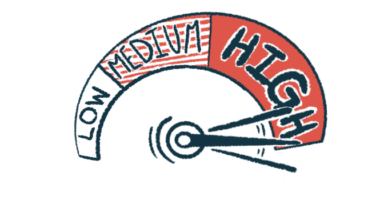From Balloons to Bubbles: How I Breathe Well With ALS

I know I have no control over how quickly or slowly my ALS progresses, but I can try to hold off the negative effects that come from long periods of sitting and shallow breathing.
Because most people with ALS experience breathing difficulties somewhere along the course of their disease, a spirometry test is among the battery of tests given to patients at an ALS clinic. This test measures how much air you can inhale and exhale, along with how fast you can empty the air out of your lungs. The now familiar verbal instructions go something like this:
Sit up straight. Take a deep breath in. Then, exhale as hard as you can and keep going for as long as you can.
During one of my initial visits to my ALS clinic, I asked for advice on what I could do at home to exercise my lungs and ensure that I continue to do well on the spirometry test.
“Practice blowing up balloons,” they said. My respiratory therapist explained that the exertion needed to blow up a balloon would help keep my diaphragm muscle strong.
At home, with a newly purchased bag of party balloons, I sat down for my first training session. Unfortunately, it was a dismal failure; blowing as hard as I could, I just couldn’t muster the extra “oomph” of air needed to fully inflate a balloon.
But rather than give up, I approached the problem differently. The same way I’ve handled the many other issues that ALS brings: I break the problem down and tackle it one thing at a time. Following are a few of the resources that helped me to learn how to keep my spirometry scores high.
Sit up straight
A good friend recommended I check out the books and videos from Esther Gokhale. Since then, Gokhale has become my go-to authority on posture.
Not only is too much sitting bad for our health, slumping and slouching in our chairs contributes to weakened muscles and shallow breathing. Most posture experts describe a healthy spine as having an “S-curve.” According to Gokhale, most of us have slouched our way into a “C-curve.”
A proper sitting position involves scooting the hips all the way to the back of the chair. Knees can fall open, and our back is resting and supported by the back of the chair. Gokhale advocates the sitting (and standing) posture found in primal cultures in which the spine assumes a “J-curve.” In this short TEDxStanford video, Gokhale demonstrates how to sit up straight.
I spend my sitting time mindful of my posture and use strategically placed pillows to help prevent slouching.
Take a deep breath in
Deep breathing depends on both our lung capacity and the strength of our torso muscles. A ribcage that expands, a flexible spine, strong abdominal muscles, and a supportive lower back all help to create space for lungs to expand.
I practice the simple exercise sequence taught by Original Strength, called Resets. These include deep diaphragmatic breathing, head nods, rolling, rocking, and crawling.
The easy-to-do movements are performed on the floor “baby-style,” but they can be adapted easily for sitting in a chair or lying on a bed mattress. I’ve been doing these for eight years now, and I feel they have contributed to my continued overall strength and mobility.
I also use a tip I picked up from voice and speech expert Andrea Caban. In her “Living Speech Series,” a course for ALS patients, she recommends doing the following when taking a spirometry test:
Don’t take a deep breath by lifting your shoulders up to your ears. Keep your shoulders relaxed and down. Focus instead on expanding the lower lungs and moving the rib cage out sideways.
Exhale as hard as you can, for as long as you can
Thanks to the worldwide community of PALS (people with ALS) and CALS (caregivers for people with ALS) who post questions and freely share tips on social media, I found an alternative to blowing up balloons.
It’s a simple setup that Lee Millard, a fellow blogger from the U.K., uses for his home practice to help strengthen his diaphragm muscle. In this post, he writes about how he inserts flexible tubing into a plastic bottle that is three-quarters full of water.
To use, take a deep breath and blow for as long as you safely can. I have to agree with Lee, that blowing bubbles is not only fun but provides visual feedback as to the strength and length of each exhale.
At a recent ALS clinic visit, the staff noted my ease in breathing and the strength of my voice. On the way out, I stopped to say hello to a couple I knew in the exam room next to mine. They laughingly shared that the clinic staff had already told them about “Dagmar’s bubble bottle,” and had recommended it to them as well!
Blow bubbles for health! Together we can learn from each other, and together we can live well while living with ALS.
***
Note: ALS News Today is strictly a news and information website about the disease. It does not provide medical advice, diagnosis, or treatment. This content is not intended to be a substitute for professional medical advice, diagnosis, or treatment. Always seek the advice of your physician or other qualified health provider with any questions you may have regarding a medical condition. Never disregard professional medical advice or delay in seeking it because of something you have read on this website. The opinions expressed in this column are not those of ALS News Today or its parent company, BioNews Services, and are intended to spark discussion about issues pertaining to ALS.








Comments
Pat Bradley
This is without a doubt one of the most informative and beneficial things I've seen / read!! If only we could get more down to earth, basic, real life things like this, it would be very helpful!! Thanks!!P
Dagmar Munn
Thank you Pat! I'm happy to know this article hit a home run for you. :-) I'm always open to suggestions for future topics that would be of interest to readers, so feel free to suggest them. Thanks again!
Doug Harbin
Thank you for the Information. My wife and I both read your article. I love to hear stories of new ideas and people living with ALS. Brilliant idea!
Dagmar Munn
Thank you Doug!
renee
Thank you so much. I recently took a breathing test and I was so scared. The technician was so calm with me. I had failed the test in the past when I tried out for a clinical trial, and I was concerned about taking the test again because I needed to pass it in order to qualify for the radicava drug. Good news! I passed. The person who gave the test to me was so patient and calm with me. I have now gone the extra mile, and I am going to take the only FDA drug approved in years. I needed to share this story because I want to be brave and slow my ALS down. My insurance company approved this drug and I only have to pay a small amount of money. I know that in the future that I might have to take this test again, and I will keep this column which I printed out in my ALS file. I so love this column. Yes, I agree that we can live well while living with ALS.
Dagmar Munn
All the best to you Renee! I'm glad my column will be of help to you!
Lee Glenn
So, how long do you blow bubbles through the straw? How many times per day?
Dagmar Munn
Lee - - Of course, since everyone has different levels of lung function and fitness, I recommend you check with your doctor or a respiratory therapist for their recommendations. In my case, I began with doing 5 dynamic and extended exhales every other day and have built up to 10 every other day.
Rose Iuro-Damon
Hello. My former husband has just been diagnosed with ALS. The family are all rallying to support him. I was delighted to find this website and quite intrigued by your breathing exercises. I'm wondering if using an incentive spirometer would provide the same benefit? While I love the simple around the house items to use, it occurred to me that seeing the markings on the incentive spirometer would be helpful as a visual tool of progress/maintenance. Thank you!
Dagmar Munn
Hello Rose - - Yes, an incentive spirometer would be a similar option. Usually it is up to the patient to indicate whether they feel more motivated by using technology or a DYI solution. Also, consider the cost; there are many expenses ahead with ALS and for many, using a simple DYI option is more economical. Personally, I like sound of and visual feedback from the bubbles! It adds a little spice into an otherwise mundane ALS-related exercise.
EdVincent
I am just a newbie into ALS..Yes,just a few days..I'd like to know all there is and how I can make it easier on me..Please direct me..tks Bud [email protected]
Dagmar Munn
Hi Bud - - So sorry that you have been diagnosed with ALS, but there are many friends in the ALS community and much helpful information for you. First, do get connected with your local ALS Association: http://www.alsa.org/ then, check out these helpful websites: http://alsnewstoday.com/2017/10/24/als-online-resources-high-marks/. Of course, do stay up to date on research and developments right here at ALS News Today. I can also offer my ALS and Wellness Blog as a resource. https://alsandwellness.blogspot.com/ Wishing you all the best.